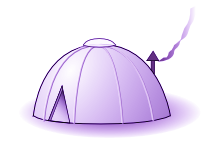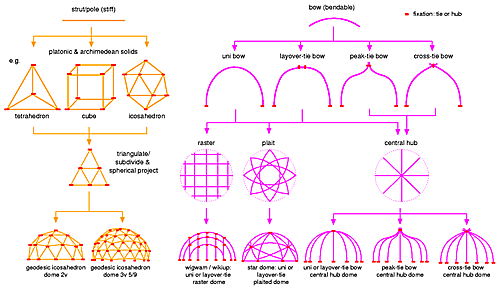UpdatesFri, December 18, 2009: Included the polyhedral and curved helix zome, not yet in the typology included.
.
Wed, July 25, 2007: First version, included dome typology with a brief overview of dome variants.
.
|
The dome or hemispherical dwelling is an ancient shelter form alike the
tipi, and there are many ways to build a dome, with bent bows or straight struts.
The dome can be implemented in many ways, e.g. a geodesic dome composed by triangles is challenging to calculate and build, especially if not a canvas is used to cover it.
A dome done with bows is much easier to plan and implement, and very simple to errect and take down as well, and the portability is very good in that case.
The comfort, if done with thermal insulation like with the yurt, is alike excellent.
Yet, there is one noteable disadvantage to be mentioned, the entire surface acts as roof and requires to be 100% waterproof therefore, whereas the yurt or cubic building have a comperable lesser vertical exposure or roof area.
This dome typology gives you an overview of the different approach to compose a dome or hemispherical shelter:

Geodesic Dome |
| Simplicity |
     |
| Size Flexibility |
     |
| Portability |
     |
| Comfort |
     |
| Overall |
     (2.75) (2.75) |
The
geodesic dome is composed by straight structural elements, so called struts which themselves connect to hubs.
It's a rather complex approach, and one of it significance and advantage is it can be fine grained as required, at any size - that why "Size Flexibility" has the highest rating.

Bow Dome |
| Simplicity |
     |
| Size Flexibility |
     |
| Portability |
     |
| Comfort |
     |
| Overall |
     (3.0) (3.0) |
The
bow dome is composed by bows, either under tension or prevent to stay in shape,
and tied to a central hub. Different ways of bending provides different shapes of the dome, like peak-tie or cross-tie bows.

Zome |
| Simplicity |
     |
| Size Flexibility |
     |
| Portability |
     |
| Comfort |
     |
| Overall |
     (3.0) (3.0) |
The
zome is either composed by straight struts or in its curved version with bent bows.
For a real life applications the zomes require further triangulation in order to be stable.
- Zome, introduction, overview and photos
- Helix Zome, curved variant of the polyhedral approach

Star Dome |
| Simplicity |
     |
| Size Flexibility |
     |
| Portability |
     |
| Comfort |
     |
| Overall |
     (2.75) (2.75) |
The
star dome is derived from a geodesic dome using bamboo splits as bows.
It's a rather simple setup, but due its defined form does not allow larger domes, that's why "Size Flexibility" rating is low.

Wigwam |
| Simplicity |
     |
| Size Flexibility |
     |
| Portability |
     |
| Comfort |
     |
| Overall |
     (3.0) (3.0) |
The
wigwam stands here rather for the way the skeleton is made, with a canvas setup.
The original
wigwam is made with tree branches, and covered with leaves or grass.
Each of the approaches has advantages and disadvantages, e.g. the
Geodesic Dome can be built almost at any size and fine grided as necessary with higher triangular subdivision and overhead to erect the dome raises significant, whereas the
Star Dome is only suitable to 7-8m in diameter, after that the gaps become to huge and require additional structure.
The
Bow Dome provides many forms with its central hub approach as you can explore the
Bow Dome Calculator, and also can be fine grided for larger domes.
The
Zome on the other hand has many features the
Geodesic Dome has but isn't natively triangulated.
.:.
















